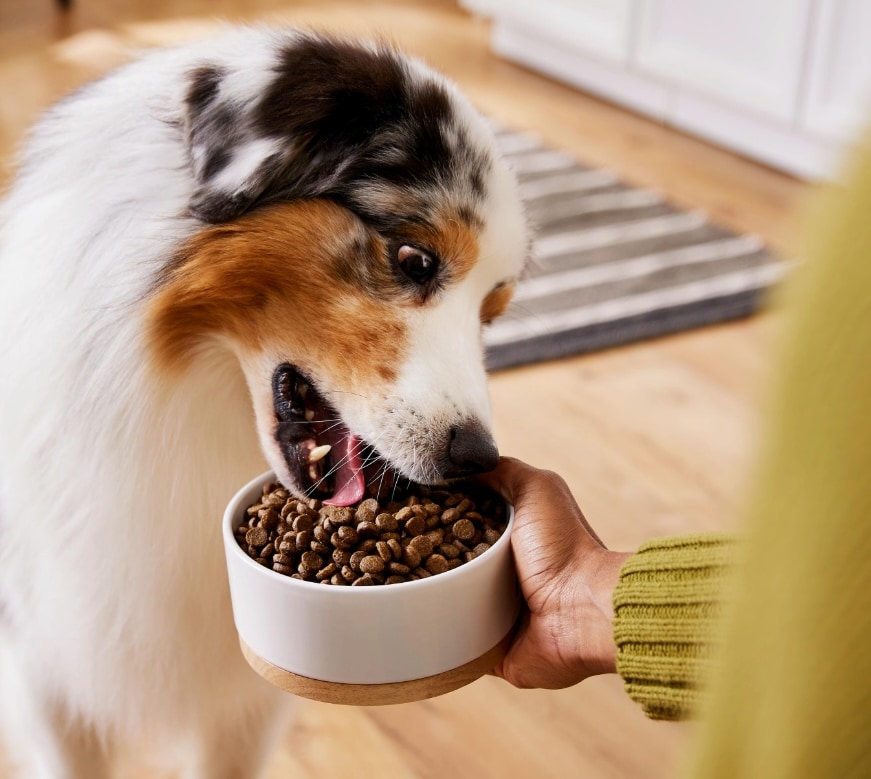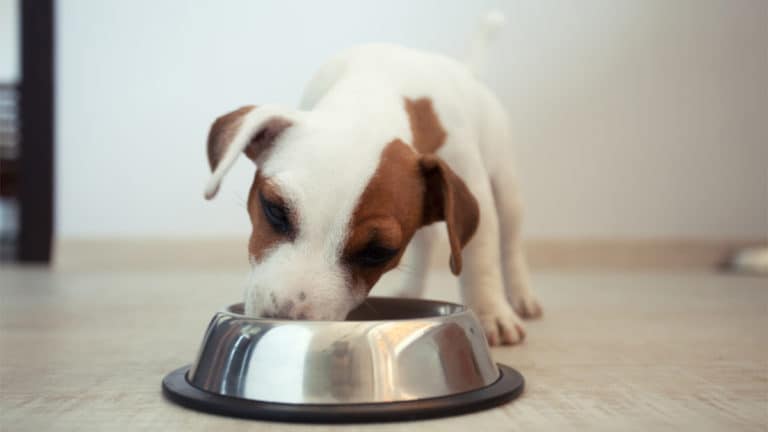Dogs and cats require a complete and well-balanced diet to keep them healthy and active. Imagine how susceptible to illness you would be if you cut natural vitamins out of your diet or how little strength you’d have if you cut out power-boosting foods that are high in protein.
Protein is a crucial part of a cat and dog's diet, just like it is in yours. “We literally can’t survive without it,” says Dr. Gary Richter, author of "The Ultimate Pet Health Guide: Breakthrough Nutrition and Integrative Care for Dogs and Cats" and veterinarian at Montclair Veterinary Hospital in Oakland, California.
Why Is Protein for Pets Important?
Protein—which is essentially a combination of amino acids—plays many roles in the body, including maintaining muscle, fur, skin and nails; making critical components of the immune system; and forming enzymes that catalyze chemical reactions in cells. Pets are built to make some amino acids themselves, but others (called “essential amino acids”) can only come from their diet.
Protein can also be an important source of energy for pets. Dogs will use protein for energy when more is eaten than is required for its other roles. Cats, on the other hand, are more dependent on protein for energy than are dogs and will break it down even if their other protein needs aren’t met.
Jump to:
Protein for Dogs

When a dog eats protein, digestive processes release its amino acids, which are then reassembled into the proteins that the animal needs. Eating too little protein forces pets to break down muscles and other tissues to gain access to the amino acids they need. This can lead to muscle wasting, immune dysfunction, a poor quality coat and other health problems.
How Much Protein Does a Dog Need?
Protein is a vital part of your pet’s diet. Ensuring that your cat or dog gets enough high-quality protein in their diet does take some work, but the rewards of health and vitality are well worth the effort.
The amount of protein that a dog needs is dependent on many factors including age, activity level, reproductive status and health status. There are several ways ensure that a dog gets enough protein.
The Association of American Feed Control Officials (AAFCO) sets minimum standards for vital pet nutrients. If you only purchase dog foods that meet AAFCO standards, you can be sure that these minimum needs are being met. Current AAFCO protein standards for dogs (on a dry matter basis) are 22.5 percent for growth and reproduction and 18 percent for adult maintenance.
The European Pet Food Industry (FEDIAF) has recently put forward nutritional guidelines that go a bit further than AAFCO’s standards. The FEDIAF breaks down the minimal nutritional needs of adult dogs based on the amount of energy they take in and provides specific recommendations for reproduction/young puppies and for puppies over 14 weeks of age:
- Adult dogs that eat less due to low energy needs: 21 grams protein/100 grams dry matter
- Adult dogs that eat more due to high energy needs: 18 grams protein/100 grams dry matter
- Early growth (<14 weeks) and reproduction: 25 grams protein/100 grams dry matter
- Late growth (>14 weeks): 20 grams protein/100 grams dry matter
Deciphering these types of recommendations is difficult. Your veterinarian can help you determine the best dietary protein range based on your dog’s particular needs.
Best Sources of Protein for Dogs
Pet owners often think there are big differences between specific sources of protein, but ultimately, the main difference is in the amino acid breakdown, says Dr. Richter, adding that "most dogs will do just fine on almost any protein.” But this general rule comes with some caveats.
For dogs, the best protein sources are often meat-based. “While it is technically possible to make a dog a vegetarian, it’s not optimal,” says Dr. Richter. Nutritionally complete and balanced vegetarian dog foods are available, but if your dog needs to eat one for health reasons or you choose to feed one for moral, ethical or environmental reasons, be sure to closely monitor their health and nutritional status.
However, even meat-based proteins are not all created equal. Diets made with whole meat proteins may be of higher quality than are those that contain lots of animal by-products (sometimes also called animal meal or animal digest) or meat meal. Animal by-products are what is left over when more desirable components are removed, and it can be difficult to tell what exactly is in them. Even within the same brand of dog food, the contents of these animal by-products can change, which means the spectrum and quality of nutrients can change as well, says Dr. Richter.
Provided your dog doesn’t have a specific food sensitivity (more on that below), Dr. Richter recommends rotating your dog through different protein sources over time. This provides a wider spectrum of amino acids and other nutrients, which may help your dog stay healthy over time.
Comparing Different Protein Sources for Dogs
Common sources of protein for pets include chicken, beef, turkey, lamb, fish, rabbit and eggs. Some foods feature one protein source prominently, while others may contain a variety of proteins in the same food.
Try these pet food options that feature wholesome protein sources for your pet:
Chicken
Chicken is a widely available and healthy source of protein for pets.
For owners who want to include a real source of chicken in their dog’s food, American Journey's Protein & Grains Chicken, Brown Rice & Vegetables Recipe Dry Dog Food is made without wheat, corn, soy, animal by-products, artificial colors or preservatives.
Be sure to practice excellent food hygiene and watch your dog for possible food-borne illness any time you feed raw foods.
Rabbit
Naturally high in protein, rabbit is a novel protein source that mixes up your pet’s diet.
Stella & Chewy’s Absolutely Rabbit Dinner Patties are made with raw, farm-raised rabbit and contain no grains, gluten, fillers, artificial colors or preservatives.
Beef
Turkey
Turkey—another common protein source—can be a healthy way to mix up your dog’s diet.
The Honest Kitchen's Whole Grain Turkey Recipe Dehydrated Dog Food features cage-free turkey along with organic whole oats, carrots, cabbage, apples and other wholesome ingredients, with no animal by-products. It’s dehydrated, which means you just add some warm water, and stir before serving to your dog.
Lamb
Lamb can be your dog’s main protein source or used as a supplement.
American Journey's Lamb & Sweet Potato Recipe Grain-Free Dry Dog Food is made with lamb as the No. 1 ingredient. It's not only packed with antioxidant-rich ingredients that help support a healthy immune system, but it also boasts omega-3 and omega-6 fatty acids that help support skin, coat, brain and eye health.
Chicken, eggs, fish
Ultimately, there is no one best protein for dogs, says Dr. Richter. He suggests feeding a fresh, whole-food diet. Your choice will depend on your individual dog and your own personal preferences.
Protein and Food Sensitivities in Dogs
According to Dr. Richter, 70 percent of a dog’s immune system lives in the gastrointestinal (GI) tract. “If there’s inflammation in the GI tract, then you can pretty much count on there being some global issues from it,” he says. These issues include gastrointestinal problems such as upset stomachs, vomiting and diarrhea, but they can also manifest as chronic skin infections or irritations, ear infections, general itchiness, or any other type of inflammation within your dog’s body, says Dr. Richter.
Unfortunately, a dog can develop an allergy or sensitivity to a specific protein source over time. But owners should note that the animal proteins are not the only things that could cause issues in your dog. Dogs can also develop a sensitivity to some of the protein components in other ingredients—for example, the protein components in wheat, rice or corn, says Dr. Richter.
He adds that issues could also arise from how the food is prepared or processed. “We may see a dog that has all kinds of trouble with a dry dog food with chicken as a protein source. But if you put her on a fresh or raw food diet with chicken, she may do just fine.”
What should you do if you suspect your dog has a protein allergy or sensitivity?
- Step one is to try a different protein, says Dr. Richter. This is one major benefit to foods that have a single source of protein instead of multiple meat sources. Although most dogs do well on proteins from multiple sources, if your dog has a dietary sensitivity, foods with a single protein source, called limited ingredient diets, will help you rule out some other variables when figuring out which food is best for her, says Dr. Richter.
- If you try several over the counter diets and your dog’s issues don’t resolve, you should speak to your veterinarian. The doctor can confirm that a food allergy or sensitivity is to blame for your dog’s symptoms and prescribe an appropriate therapeutic diet.
Protein for Cats
Cats need to eat more protein than do dogs. In fact, the Nation Research Council’s recommended protein allowance for cats (50 grams/kilocalorie) is twice that for dogs (25 grams/kilocalorie).
How Much Protein Does a Cat Need?
Current AAFCO standards for protein for cats (on a dry matter basis) are 30 percent for growth and reproduction and 26 percent for adult maintenance. If you only purchase cat foods that meet AAFCO standards, you can be sure that, at the very least, your cat’s minimum protein needs are being met.
The FEDIAF’s nutritional guidelines provide two levels of protein for adult cats based on the amount of energy they need to take in and individual recommendations for growth and reproduction:
- Adult cats that eat less due to low energy needs: 33.3 grams protein/100 grams dry matter
- Adult cats that eat more due to high energy needs: 25 grams protein/100 grams dry matter
- Growth: 28 grams protein/100 grams dry matter
- Reproduction: 30 grams protein/100 grams dry matter
But, many cats prefer and would probably be healthier if they eat more protein than these minimums. A 2017 study found that when given the option of eating a variety of foods cats selected “an overall diet composition that provided 53 percent of metabolizable energy as protein, 11 percent as carbohydrate and 36 percent as fat. The protein contribution corresponded to approximately 6 grams of protein/kilograms body weight/day.”
Talk to your veterinarian to determine whether your cat’s food is providing ideal levels of protein based on her unique set of needs.
Best Protein Sources for Cats
Cats are obligate carnivores. This means they have special nutritional requirements—including an extra essential amino acid (taurine), the essential fatty acid arachidonic acid, and some important vitamins—that can only be met by eating animal tissue. Cats who are deficient in these nutrients are at significant risk for eye disease, skin and coat problems, blood clotting disorders, immune system dysfunction, poor growth, weight loss, inflamed gums, diarrhea and neurologic disorders.
Diets that are high in animal-based protein, moderate in fat and low in carbohydrates are best for cats. High-quality wet foods more closely match this nutrient distribution than do most dry foods, but some kibbles are better than others.
Another benefit of wet food is that kitties are naturally inclined to get their water from their foods rather than drinking from a bowl. You can help ensure that your cat is well-hydrated by feeding wet foods. You also can offer a combination of wet cat food and high-protein kibble.
Comparing Different Protein Sources for Cats
The best protein sources for cats come from animals, including meats and fish.
Try these pet food options that feature protein sources for your pet:
Chicken
Chicken is a wonderful source of protein for cats and is often included in high-protein dry cat foods.
American Journey's Chicken Recipe Grain-Free Dry Cat Food contains 40 percent high-quality protein from real, deboned chicken as the first ingredient. This well-rounded, balance diet also boasts a blend of antioxidants and nutrient-rich fruits and vegetables, like pumpkin and carrots.
Salmon
Salmon can provide cats with beneficial omega-3 fatty acids as well as being a nutritious source of protein.
Wild-caught salmon, like that found in Tiki Cat Hanalei Luau Wild Salmon Canned Cat Food, is healthier than farm-raised salmon.
Beef
Duck
Mix
Protein and Food Sensitivities in Cats
Dr. Richter stated that the majority of a dog’s immune system lives in the gastrointestinal tract. The same is true for cats, and when that part of the immune system malfunctions, food allergies can be the result.
Food intolerances do not involve the immune system but include other types of adverse reactions to specific ingredients in a cat’s diet. Food intolerances typically cause gastrointestinal problems, like vomiting and diarrhea, while food allergies tend to lead to chronic itchiness and skin infections with or without digestive upset.
Protein sensitivities often resolve when cats are fed a novel protein cat food. Look for a product that contains a single, major protein source that your cat has never been exposed to before. Venison or duck may be good first options, but talk to your veterinarian if your cat’s symptoms fail to improve. Therapeutic diets that require veterinary approval are sometimes needed to diagnose and treat severe food sensitivities.
More on protein for pets:
Share:










